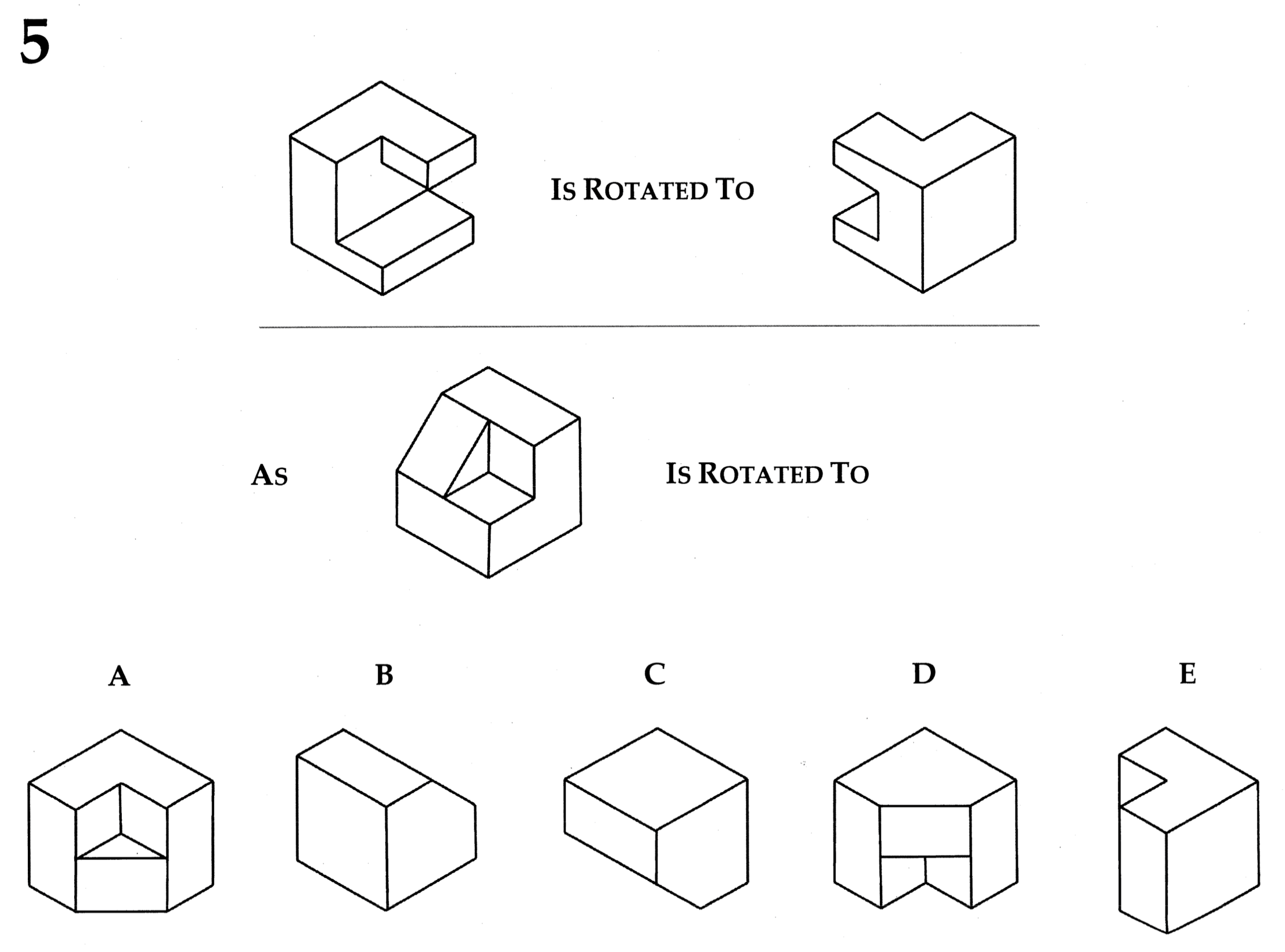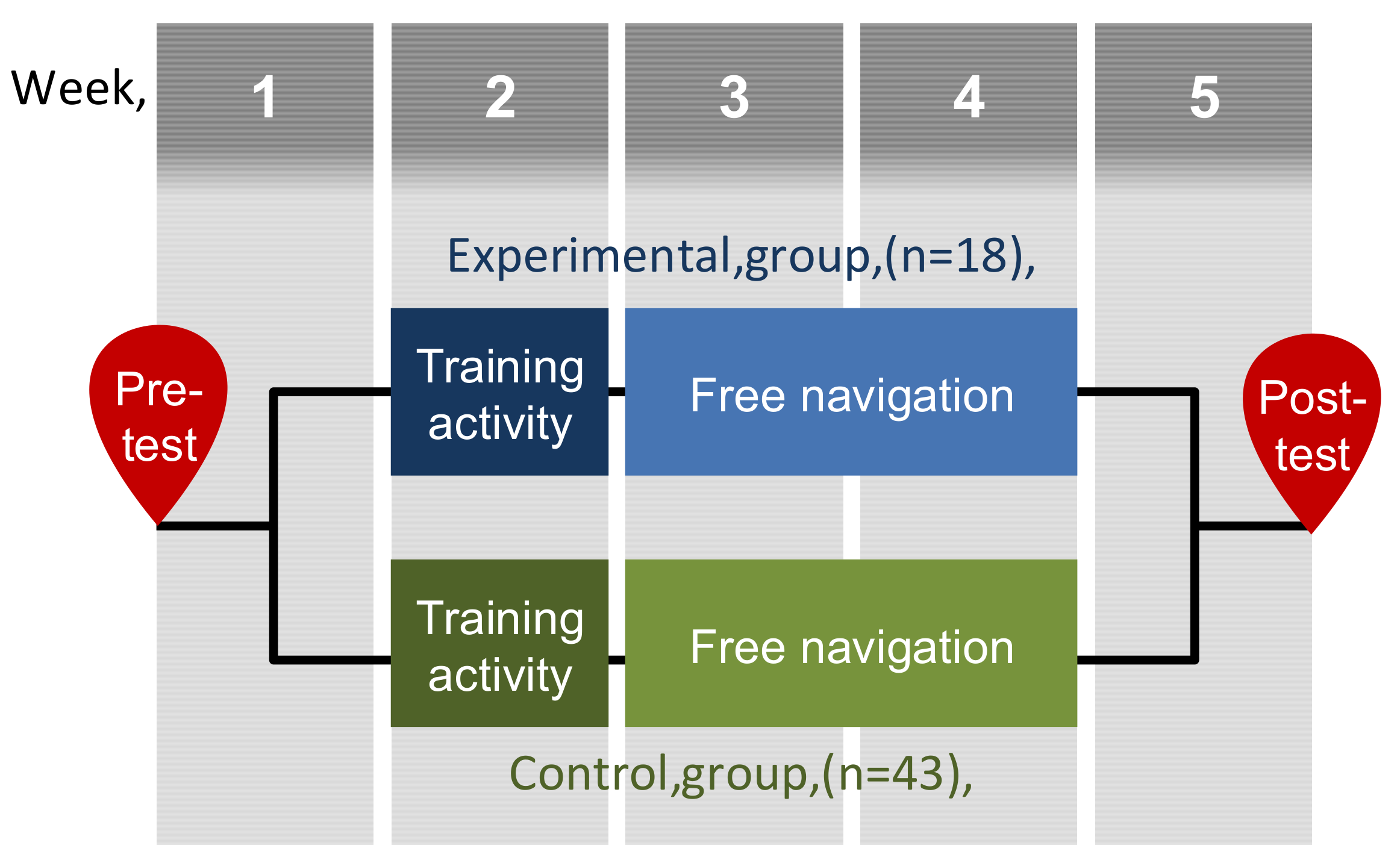Virtual Reality Learning Activities for Multimedia Students to Enhance Spatial Ability
Abstract
1. Introduction
2. VR Tool for Spatial Ability Enhancement
2.1. Models
2.2. Visualization and Interaction
2.3. Navigation
- Orbital navigation, which allows zooming in and out the object and rotating it around a predefined rotation axis.
- First person, consisting of a free navigation of the observer, in first person.
- Models 1 and 2 have no predefined movements, so only orbital or first-person navigation is available.
- For model 3 there is a sequence of movements available, consisting of the following three transformations, performed sequentially: rotation of −90° around the Y-axis, rotation of −180° around the Z-axis, and rotation of −90° around the Y-axis.
- For model 4, the sequence of movements available is a little more complex: 100-unit translation on the Z-axis, −100-unit translation on the Z-axis and simultaneously −180° rotation around the X-axis, and finally a 90° rotation around the Y-axis.
3. Method
3.1. Academic Context
- Know and apply basic computer graphics techniques, including 2D, 3D, rendering and lighting.
- Design, construct and animate three-dimensional models, including all stages required for the production of an image or infographic sequence.
- Design and develop video games and simulation systems.
- Acquire and apply the principles, techniques and technologies of Virtual Reality.
- Know, apply and optimize techniques for the development of complex games including advanced graphics, physical engines for videogames, artificial intelligence and network games.
3.2. Participants
3.3. Instruments
3.4. Procedure
3.4.1. Pre-Test
3.4.2. Performing the Training Activity
- Firstly, models 3 and 4 were displayed following the pre-established sequence of movements, as explained in section 0 (20 min).
- Secondly, free navigation was carried out in the viewfinder, with the following requirements: the four models were to be displayed, the two navigation modes (orbital and first-person) were to be used, and the four elevations and two plan views of each model were to be displayed (20 min).
3.4.3. Free Navigation
3.4.4. Post-Test
3.5. Design and Data Analysis
4. Results
5. Discussion and Conclusions
Acknowledgments
Author Contributions
Conflicts of Interest
References
- Merchant, Z.; Goetz, E.T.; Cifuentes, L.; Keeney-Kennicutt, W.; Davis, T.J. Effectiveness of virtual reality-based instruction on students’ learning outcomes in K-12 and higher education: A meta-analysis. Comput. Educ. 2014, 70, 29–40. [Google Scholar] [CrossRef]
- Akçayır, M.; Akçayır, G. Advantages and challenges associated with augmented reality for education: A systematic review of the literature. Educ. Res. Rev. 2017, 20, 1–11. [Google Scholar] [CrossRef]
- Passig, D.; Tzuriel, D.; Eshel-Kedmi, G. Improving children’s cognitive modifiability by dynamic assessment in 3D Immersive Virtual Reality environments. Comput. Educ. 2016, 95, 296–308. [Google Scholar] [CrossRef]
- Petrakou, A. Interacting through avatars: Virtual worlds as a context for online education. Comput. Educ. 2010, 54, 1020–1027. [Google Scholar] [CrossRef]
- Dalgarno, B.; Lee, M.J.; Carlson, L.; Gregory, S.; Tynan, B. An Australian and New Zealand scoping study on the use of 3D immersive virtual worlds in higher education. Australas. J. Educ. Technol. 2011, 27, 1–15. [Google Scholar] [CrossRef]
- Aggarwal, R.; Grantcharov, T.P.; Eriksen, J.R.; Blirup, D.; Kristiansen, V.B.; Funch-Jensen, P.; Darzi, A. An Evidence-Based Virtual Reality Training Program for Novice Laparoscopic Surgeons. Ann. Surg. 2006, 244, 310–314. [Google Scholar] [CrossRef] [PubMed]
- Lemole, G.M.; Banerjee, P.P.; Luciano, C.; Neckrysh, S.; Charbel, F.T. Virtual reality in neurosurgical education: Part-task ventriculostomy simulation with dynamic visual and haptic feedback. Neurosurgery 2007, 61, 142–148. [Google Scholar] [CrossRef] [PubMed]
- Rubio-Tamayo, J.L.; Gértrudix, M.; Sáez-López, J.-M. Entornos Virtuales, Realidad Aumentada y DBR en el Contexto de Aprendizaje Situado: Intervenciones con Scratch, Aurasma y Kodu. Available online: https://dialnet.unirioja.es/servlet/articulo?codigo=5394937 (accessed on 2 April 2018).
- Bruno, F.; Muzzupappa, M. Product interface design: A participatory approach based on virtual reality. Int. J. Hum. Comput. Stud. 2010, 68, 254–269. [Google Scholar] [CrossRef]
- Hashemipour, M.; Manesh, H.F.; Bal, M. A modular virtual reality system for engineering laboratory education. Comput. Appl. Eng. Educ. 2011, 19, 305–314. [Google Scholar] [CrossRef]
- Impelluso, T.; Metoyer-Guidry, T. Virtual Reality and Learning by Design: Tools for Integrating Mechanical Engineering Concepts. J. Eng. Educ. 2001, 90, 527–534. [Google Scholar] [CrossRef]
- Jimeno-Morenilla, A.; Sánchez-Romero, J.L.; Salas-Pérez, F. Augmented and virtual reality techniques for footwear. Comput. Ind. 2013, 64, 1371–1382. [Google Scholar] [CrossRef]
- Nomura, J.; Sawada, K. Virtual reality technology and its industrial applications. Annu. Rev. Control 2001, 25, 99–109. [Google Scholar] [CrossRef]
- Ong, S.K.; Mannan, M.A. Virtual Reality Simulations and Animations in a Web-based Interactive Manufacturing Engineering Module. Comput. Educ. 2004, 43, 361–382. [Google Scholar] [CrossRef]
- Shen, Y.; Ong, S.K.; Nee, A.Y.C. Augmented reality for collaborative product design and development. Des. Stud. 2010, 31, 118–145. [Google Scholar] [CrossRef]
- Stone, R. Virtual reality for interactive training: An industrial practitioner’s viewpoint. Int. J. Hum. Comput. Stud. 2001, 55, 699–711. [Google Scholar] [CrossRef]
- Zwolinski, P.; Tichkiewitch, S.; Sghaier, A. The Use of Virtual Reality Techniques during the Design Process: From the Functional Definition of the Product to the Design of its Structure. CIRP Ann. 2007, 56, 135–138. [Google Scholar] [CrossRef]
- Miyata, K.; Umemoto, K.; Higuchi, T. An educational framework for creating VR application through groupwork. Comput. Graph. 2010, 34, 811–819. [Google Scholar] [CrossRef]
- Akçayır, M.; Akçayır, G.; Pektaş, H.M.; Ocak, M.A. Augmented reality in science laboratories: The effects of augmented reality on university students’ laboratory skills and attitudes toward science laboratories. Comput. Hum. Behav. 2016, 57, 334–342. [Google Scholar] [CrossRef]
- Carbonell, C.; Saorín, J.; Melian, D.; Cantero, J.; Cantero, T. 3D Creative Teaching-Learning Strategy in Surveying Engineering Education. Eurasia J. Math. Sci. Technol. Educ. 2017, 13, 1–14. [Google Scholar] [CrossRef]
- Abulrub, A.-H.G.; Attridge, A.; Williams, M.A. Virtual Reality in Engineering Education: The Future of Creative Learning. Int. J. Emerg. Technol. Learn. IJET 2011, 6. [Google Scholar] [CrossRef]
- Jimeno-Morenilla, A.; Sánchez-Romero, J.L.; Mora-Mora, H.; Coll-Miralles, R. Using virtual reality for industrial design learning: A methodological proposal. Behav. Inf. Technol. 2016, 35, 897–906. [Google Scholar] [CrossRef]
- Saleeb, N.; Dafoulas, G.A. Effects of Virtual World Environments in Student Satisfaction: An Examination of the Role of Architecture in 3D Education. Int. J. Knowl. Soc. Res. IJKSR 2011, 2, 29–48. [Google Scholar] [CrossRef][Green Version]
- Thorsteinsson, G.; Page, T. Creativity in Technology Education Facilitated through Virtual Reality Learning Environments: A Case Study. J. Educ. Technol. 2007, 3, 74–87. [Google Scholar]
- Torrance, E.P. The Torrance Tests of Creative Thinking–Norms-Technical Manual Research Edition–Verbal Tests, Forms A and B–Figural Tests, Forms A and B; Personnel Press: Princeton, NJ, USA, 1966. [Google Scholar]
- Bell, J.T.; Fogler, H.S. Investigation and application of virtual reality as an educational tool. In Proceedings of the American Society for Engineering Education 1995; ASEE–American Society for Engineering Education: Anaheim, CA, USA, 1995; Volume 2, pp. 1718–1728. [Google Scholar]
- Felder, R.M.; Silverman, L.K. Learning and teaching styles in engineering education. Eng. Educ. 1988, 78, 674–681. [Google Scholar]
- Bloom, B.S.; Krathwohl, D.R.; Masia, B.S. Taxonomy of Educational Objectives. The Classification of Educational Goals: Cognitive Domain Handbook 1; Longman: New York, NY, USA, 1956; ISBN 978-0-582-28010-6. [Google Scholar]
- Kirakowski, J. The Use of Questionnaire Methods for Usability Assessment. Available online: http://sumi.uxp.ie/about/sumipapp.html (accessed on 29 December 2017).
- Sutcliffe, A.; Gault, B. Heuristic evaluation of virtual reality applications. Interact. Comput. 2004, 16, 831–849. [Google Scholar] [CrossRef]
- Rizzo, A.A.; Buckwalter, J.G.; Larson, P.; van Rooyen, A.; Kratz, K.; Neumann, U.P.; Kesselman, C.; Thiébaux, M. Preliminary Findings on a Virtual Environment Targeting Human Mental Rotation/Spatial Abilities. Available online: https://www.semanticscholar.org/paper/Preliminary-findings-on-a-virtual-environment-human-Rizzo-Buckwalter/7468c5841bc569722902cd87f9fa7fa446b497c5 (accessed on 2 April 2018).
- Carroll, M.; Johnston, M.; Hale, K.S. Visual Perceptual Skills Training in Virtual Environments. In Handbook of Virtual Environments: Design, Implementation, and Applications, 2nd ed.; Hale, K.S., Stanney, K.M., Eds.; CRC Press: Boca Raton, FL, USA, 2014; pp. 1029–1042. ISBN 978-1-4665-1185-9. [Google Scholar]
- Hale, K.S.; Stanney, K.M. Handbook of Virtual Environments: Design, Implementation, and Applications, 2nd ed.; CRC Press: Boca Raton, FL, USA, 2014; ISBN 978-1-4665-1185-9. [Google Scholar]
- Carbonell-Carrera, C.; Saorin, J.L. Virtual Learning Environments to Enhance Spatial Orientation. Eurasia J. Math. Sci. Technol. Educ. 2017. [Google Scholar] [CrossRef]
- Lin, C.-H.; Chen, C.-M.; Lou, Y.-C. Developing Spatial Orientation and Spatial Memory with a Treasure Hunting Game. Educ. Technol. Soc. 2014, 17, 79–92. [Google Scholar]
- Dünser, A.; Steinbügl, K.; Kaufmann, H.; Glück, J. Virtual and Augmented Reality as Spatial Ability Training Tools; ACM Press: New York, NY, USA, 2006; pp. 125–132. [Google Scholar]
- Jou, M.; Wang, J. Investigation of Effects of Virtual Reality Environments on Learning Performance of Technical Skills. Comput. Hum. Behav. 2013, 29, 433–438. [Google Scholar] [CrossRef]
- Bodner, G.M.; Guay, R.B. The Purdue Visualization of Rotations Test. Chem. Educ. 1997, 2, 1–17. [Google Scholar] [CrossRef]
- Sketchfab Sketchfab. Available online: https://sketchfab.com (accessed on 18 December 2017).
- Universidad de Alicante Degree in Multimedia Engineering. Available online: https://cvnet.cpd.ua.es/webcvnet/planestudio/planEstudioND.aspx?plan=C205&lengua=E (accessed on 4 April 2018).
- Roca-González, C. Virtual Technologies to Develop Visual-Spatial Ability in Engineering Students. EURASIA J. Math. Sci. Technol. Educ. 2017, 13. [Google Scholar] [CrossRef]
- Yue, J. Spatial Visualization Skills at Various Educational Levels. In Proceedings of the 2002 American Society for Engineering Education Annual Conference & Exposition, Montreal, QC, Canada, 16–19 June 2002; pp. 7.1014.1–7.1014.10. [Google Scholar]
- Ledesma, R.; Macbeth, G.; Cortada De Kohan, N. Tamaño del efecto: Revisión teórica y aplicaciones con el sistema estadístico ViSta. Rev. Latinoam. Psicol. 2008, 40, 425–439. [Google Scholar]





| Students | Female | Male | Age | |
|---|---|---|---|---|
| Experiment | 18 | 3 (16.7%) | 15 (83.3%) | 22.8 |
| Control | 43 | 4 (9.3%) | 39 (90.7%) | 22.5 |
| Total | 61 | 7 | 54 | 22.6 |
| Group | Score Mean | Standard Deviation | N | |||
|---|---|---|---|---|---|---|
| Pre-Test | Post-Test | Pre-Test | Post-Test | Pre-Test | Post-Test | |
| Control | 21.12 | 21.98 | 5.905 | 5.958 | 43 | 43 |
| Experimental | 22.00 | 25.17 | 5.901 | 4.232 | 18 | 18 |
| Source | gl | F | p | η2 Partial | Obs. Power a |
|---|---|---|---|---|---|
| Intersection | 1 | 868,772 | 0.000 | 0.936 | 1.000 |
| Group | 1 | 1.770 | 0.189 | 0.029 | 0.258 |
| Error | 59 | (59.493) |
| Source | gl | F | p | η2 Partial | Obs. Power a |
|---|---|---|---|---|---|
| Spatial ability | 1 | 17.759 | 0.000 | 0.231 | 0.986 |
| Spatial ability * Group | 1 | 5.824 | 0.019 | 0.090 | 0.661 |
| Error (Spatial ability) | 59 | (5.794) |
| Time of Implementation | Group | t | p | Confidence Interval 95% Lower Upper | η2 Partial | Obs. Power b | |
|---|---|---|---|---|---|---|---|
| Pre-test | Intersection | 15.810 | 0.000 | 19.216 | 24.784 | 0.809 | 1.000 |
| Control | −0.533 | 0.596 | −4.200 | 2.433 | 0.005 | 0.082 | |
| Experimental | |||||||
| Post-test | Intersection | 19.355 | 0.000 | 22.565 | 27.768 | 0.864 | 1.000 |
| Control | −2.060 | 0.044 | −6.289 | −0.091 | 0.067 | 0.526 | |
| Experimental | 0 a | ||||||
© 2018 by the authors. Licensee MDPI, Basel, Switzerland. This article is an open access article distributed under the terms and conditions of the Creative Commons Attribution (CC BY) license (http://creativecommons.org/licenses/by/4.0/).
Share and Cite
Molina-Carmona, R.; Pertegal-Felices, M.L.; Jimeno-Morenilla, A.; Mora-Mora, H. Virtual Reality Learning Activities for Multimedia Students to Enhance Spatial Ability. Sustainability 2018, 10, 1074. https://doi.org/10.3390/su10041074
Molina-Carmona R, Pertegal-Felices ML, Jimeno-Morenilla A, Mora-Mora H. Virtual Reality Learning Activities for Multimedia Students to Enhance Spatial Ability. Sustainability. 2018; 10(4):1074. https://doi.org/10.3390/su10041074
Chicago/Turabian StyleMolina-Carmona, Rafael, María Luisa Pertegal-Felices, Antonio Jimeno-Morenilla, and Higinio Mora-Mora. 2018. "Virtual Reality Learning Activities for Multimedia Students to Enhance Spatial Ability" Sustainability 10, no. 4: 1074. https://doi.org/10.3390/su10041074
APA StyleMolina-Carmona, R., Pertegal-Felices, M. L., Jimeno-Morenilla, A., & Mora-Mora, H. (2018). Virtual Reality Learning Activities for Multimedia Students to Enhance Spatial Ability. Sustainability, 10(4), 1074. https://doi.org/10.3390/su10041074







